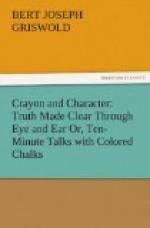Your response may be, “But, I can’t draw.” Listen! The following instructions will teach you how to do the work without a technical or practical knowledge of drawing. Let us take up the matter step by step. When you understand the process, it will be “as easy as falling off a log,” and it won’t jolt you half as much.
The Method Explained.
THE FIRST STEP—Before the time comes to give your talk, attach half a dozen sheets of your drawing paper to your drawing board, making a smooth drawing surface. It is well to use thumb tacks for this purpose. Open the book to page 26, for we will prepare to give the chalk talk entitled “The Two Faces.” The upper picture. Fig. 7, shows the picture partly finished; the lower picture, Fig. 8, shows how the picture will look when completed. You will note that the lower picture is cut up into squares measuring one-fourth of an inch each way.
THE SECOND STEP—By the use of a yardstick and lead pencil, draw pencil lines on the large sheets of drawing paper, so as to separate the drawing paper into the same number of squares as there are on the picture in the book. Your paper is much larger than the page of the book; therefore the squares on your drawing paper must be made much larger than the squares in the book. It is easy to calculate the size of the squares you should draw on the paper. Measure the width of the paper in inches and divide by sixteen (the number of squares across the picture in the book), and this will give you the figure representing the size of the squares you are to draw on the paper. If your drawing paper is thirty-two inches wide, your squares will measure two inches each way.
THE THIRD STEP—Select one of the squares in Fig. 8 as a starting point, and then find the corresponding square on your drawing paper. Having done this, draw a pencil line on your drawing paper, which will cross your enlarged squares in just the same places that the line crosses the small squares in the book. Continue the process until both faces have been outlined on your paper in the enlarged form. Then, with a piece of soft rubber, erase all of the straight pencil lines which form the squares, and the remaining outlines of the two faces will stand out clear and distinct. Already you will have found that you are more of an artist than you thought you were! This sheet of paper, with its dim pencil outlines of the picture, is now ready to be brought before your audience. You must, however, be sure of one thing: the pencil outlines must be just plain enough for you to see them without difficulty, but they must be dimmed with the eraser to such an extent that your audience cannot see them. Thus you have before you a complete outline of the picture you are to draw, and, as you speak, you merely trace over these dim pencil outlines with your chalk. Isn’t it simple?




